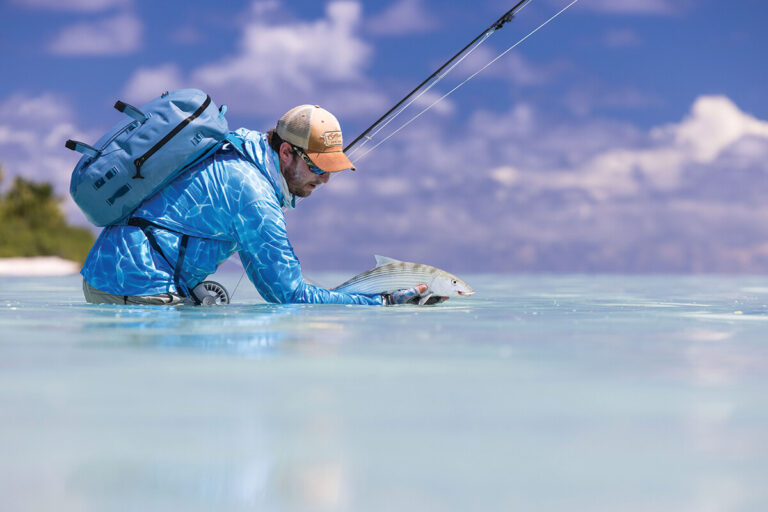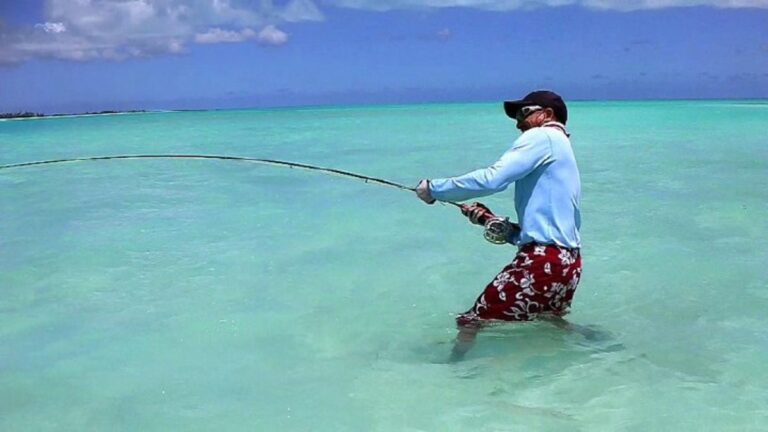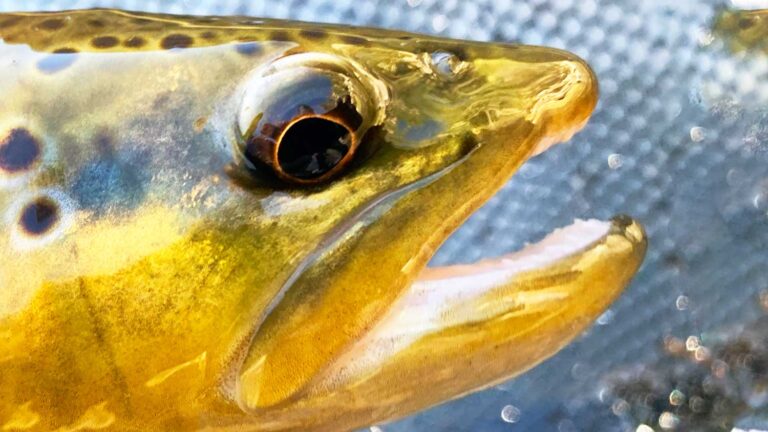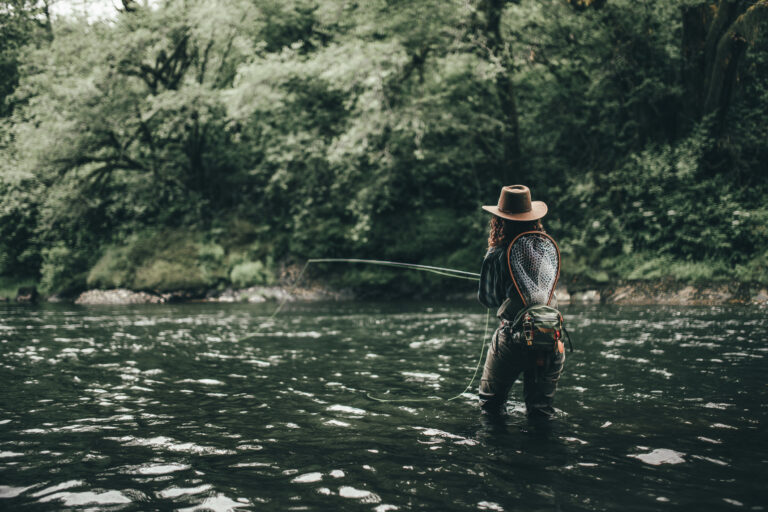Bonefishing and flats fishing are two popular types of fishing, with the main difference being the species targeted. Bonefishing focuses on catching bonefish, which are known for their speed and challenging nature, while flats fishing involves fishing on shallow, calm waters known as flats, targeting various species like tarpon, permit, and redfish.
Both activities require specific equipment like lightweight rods and specialized flies or lures, but bonefishing typically involves more sight fishing and requires anglers to locate and cast directly at individual fish, while flats fishing often involves covering a larger area and prospecting for fish.
Each type offers a unique experience, challenging anglers in different ways and providing opportunities to catch different species.
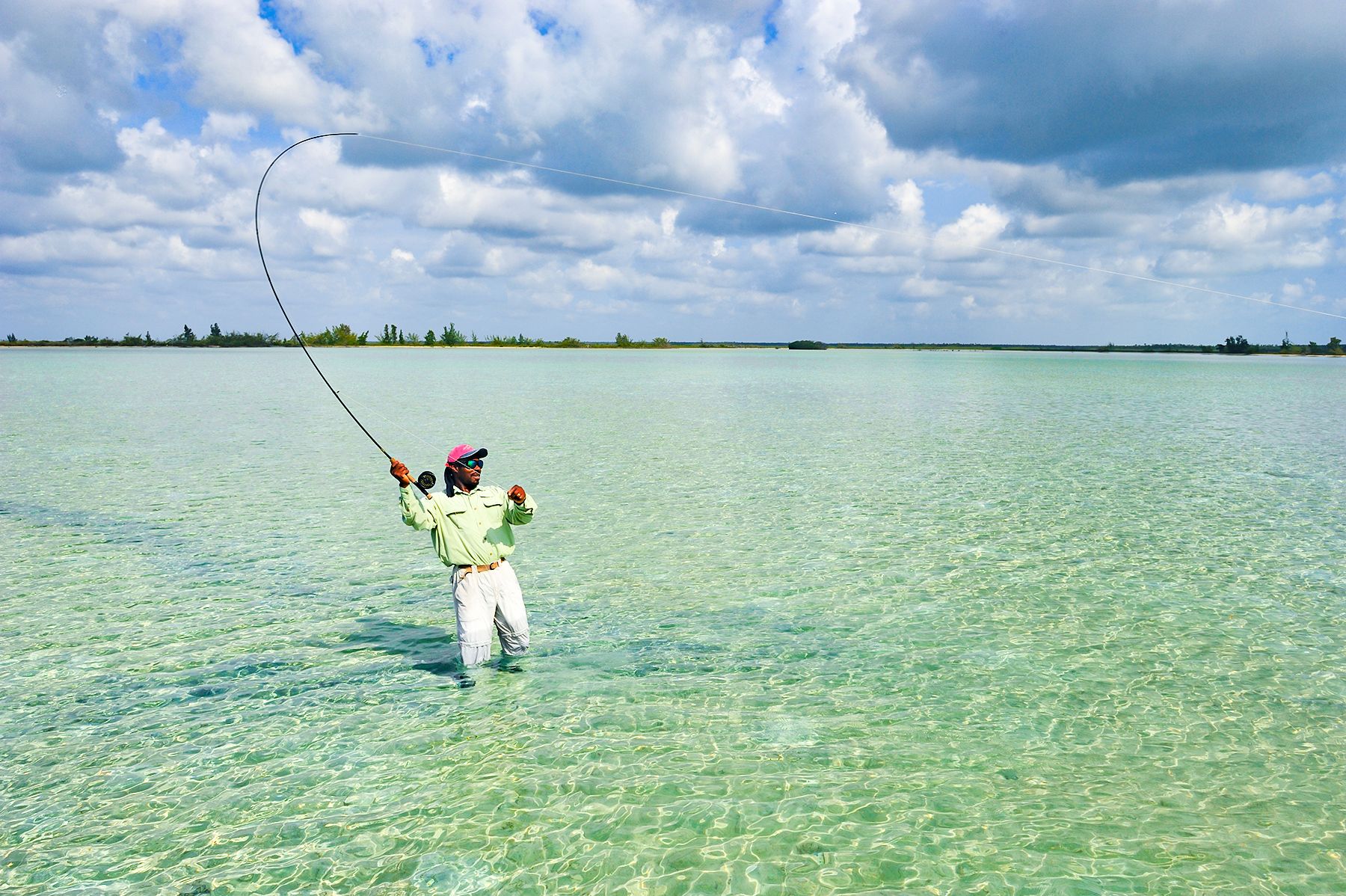
Credit: www.sandals.com
Understanding Bonefishing And Flats Fishing
The Popularity Of Bonefishing And Flats Fishing
Bonefishing and flats fishing have gained immense popularity among anglers, offering unique and exciting experiences on the water. Whether you are an experienced angler or a beginner, these specialized fishing techniques have captured the attention of fishing enthusiasts around the world.
Here are the key points to understand about the popularity of bonefishing and flats fishing:
- Exhilarating challenges: Bonefishing and flats fishing provide a thrilling challenge as you navigate the shallow waters to target elusive bonefish and other species. The anticipation of spotting fish in clear waters and making that perfect cast is an adrenaline rush like no other.
- Beautiful natural surroundings: These fishing techniques often take place in stunning natural environments such as shallow flats, mangroves, and coral reefs. The pristine beauty of these locations adds to the allure of bonefishing and flats fishing, creating a tranquil escape from the busy world.
- Accessible for all skill levels: Whether you are a seasoned angler or a novice, bonefishing and flats fishing cater to all skill levels. While experienced anglers can showcase their expertise in spotting and stalking fish, beginners can also easily grasp the basics and enjoy their time on the flats.
- Fantastic recreational sport: Bonefishing and flats fishing not only offer a thrilling fishing experience but also serve as a recreational sport. The combination of physical activity, mental focus, and the chance to catch trophy-worthy fish makes it an all-encompassing sport that keeps anglers coming back for more.
The Allure Of Fishing In Shallow Waters
Fishing in shallow waters, whether it’s bonefishing or flats fishing, presents a unique set of advantages and challenges. Here are the key points to understand about the allure of fishing in shallow waters:
- Close interaction with nature: Shallow water fishing allows anglers to get up close and personal with nature. Being in such close proximity to fish and the vibrant ecosystem of the flats provides a sense of connection and appreciation for the natural world.
- Clear visibility: One of the main benefits of fishing in shallow waters is the clarity of the surroundings. The crystal-clear waters give anglers the ability to spot fish, observe their behavior, and make precise casts. This visual aspect enhances the overall experience and increases the chances of success.
- Diverse fish species: Shallow waters are home to a myriad of fish species, making it an inviting playground for anglers. From bonefish and tarpon to permit and redfish, the diversity of species adds to the excitement and variety of the fishing experience.
- Stealth and strategy: In order to successfully fish in shallow waters, anglers must employ stealth and strategy. Quietly approaching fish without spooking them and utilizing specific techniques to entice a strike requires skill and precision. This aspect of shallow water fishing adds a thrilling element to the overall adventure.
- Environmental awareness: Fishing in shallow waters encourages environmental awareness and conservation. Anglers fishing in these delicate ecosystems must respect the habitat, practice catch and release, and contribute to the preservation of these invaluable natural resources.
Bonefishing and flats fishing have gained popularity due to the exhilarating challenges they offer, the breathtaking natural surroundings, and the accessibility for anglers of all skill levels. Fishing in shallow waters provides a unique experience with its close interaction with nature, clear visibility, diverse fish species, and the need for stealth and strategy.
Embarking on a bonefishing or flats fishing trip allows anglers to immerse themselves in the beauty of nature while enjoying an exciting and rewarding fishing adventure.
Location And Habitat
Bonefishing Hotspots Around The World
The thrilling sport of bonefishing has gained popularity among anglers worldwide. Bonefish are known for their incredible strength and speed, making them a highly sought-after gamefish. If you’re interested in embarking on a bonefishing adventure, here are some of the top bonefishing hotspots around the world:
- Bahamas: The crystal-clear waters of the bahamas offer prime bonefishing opportunities. From the picturesque islands of andros and eleuthera to the renowned flats of abaco, the bahamas is a bonefisherman’s paradise. The sheer size and abundance of bonefish in the bahamian waters make it a must-visit destination.
- Seychelles: Located in the indian ocean, the seychelles is a true angler’s dream. Its remote coral flats provide the perfect habitat for bonefish. With the added bonus of stunning scenery and untouched beaches, the seychelles offers a unique and unforgettable bonefishing experience.
- Belize: The pristine flats of belize attract anglers from all over the world. The coastal region of ambergris caye, belize’s largest island, is particularly renowned for its exceptional bonefishing opportunities. The warm, shallow waters, combined with a healthy population of bonefish, make belize a must-visit destination for avid anglers.
- Florida keys: Known as the “sportfishing capital of the world,” the florida keys offer excellent bonefishing opportunities. From key largo to key west, the shallow, sandy flats attract bonefish year-round. The keys provide both experienced and novice anglers with the chance to test their skills and land some impressive bonefish.
Flats Fishing In Different Coastal Regions
Flats fishing is a popular angling technique that involves targeting fish in shallow, calm waters known as flats. These flats can be found in various coastal regions around the world. Here are some key locations where flats fishing is particularly popular:
- Florida: The sunshine state is synonymous with flats fishing. With its extensive coastline and diverse habitats, florida offers endless opportunities for catching a wide range of fish species. Whether you’re exploring the flats of the florida keys or the flats along the gulf coast, you’re guaranteed an exciting flats fishing adventure.
- Hawaii: While best known for its big game fishing, hawaii also boasts impressive flats fishing options. The flats around the islands of oahu and maui provide excellent opportunities to catch bonefish, trevally, and other prized species. The stunning backdrop of volcanic landscapes and clear blue waters only adds to the allure of flats fishing in hawaii.
- Australia: With its vast coastline and diverse marine ecosystems, australia is a prime destination for flats fishing. The flats of exmouth in western australia are particularly renowned for their abundance of species such as bonefish, permit, and barramundi. From the great barrier reef to the kimberley region, australia offers ample opportunities for an unforgettable flats fishing experience.
- Mexico: Mexico’s coastal regions, including the yucatan peninsula and the mexican caribbean, are famous for their flats fishing opportunities. The flats in areas like cancun, isla holbox, and ascension bay attract anglers in search of bonefish, permit, and tarpon. The warm, shallow waters and vibrant marine life make mexico a top flats fishing destination.
Embarking on a bonefishing or flats fishing adventure allows anglers to experience the thrill of targeting elusive gamefish in breathtaking coastal locations. Whether you choose to explore bonefishing hotspots or enjoy flats fishing in different regions, the excitement and challenges of these angling techniques are sure to create memories that last a lifetime.
So, grab your fishing gear and get ready for an unforgettable fishing journey!
Target Species And Fishing Techniques
Bonefishing and flats fishing are two popular types of fishing experiences that offer unique opportunities for anglers. While they may share some similarities, there are distinct differences in terms of target species and fishing techniques. Let’s dive deeper into each of these fishing styles.
Bonefish: Characteristics And Preferred Bait
- Bonefish are the primary target species in bonefishing. These elusive creatures are known for their incredible speed and strength, making them a challenging opponent for anglers.
- They are typically found in shallow, tropical waters, particularly in the flats and mangrove-lined channels of the caribbean, the bahamas, and the florida keys.
- Bonefish have a distinct appearance, featuring a silvery-gray body and long, slender shape. Their size can vary, but they generally range from 2 to 5 pounds, with larger specimens weighing up to 15 pounds.
- When it comes to bait, bonefish are primarily attracted to small crustaceans such as shrimp, crabs, and small baitfish. Many anglers opt for artificial flies or lures that mimic these natural prey items, using an array of colors and patterns to entice the fish.
Flats Fishing: Diverse Range Of Species And Corresponding Fishing Methods
- Flats fishing, on the other hand, offers a wider variety of target species beyond just bonefish. The flats are teeming with an abundant ecosystem, providing opportunities to catch tarpon, permit, snook, redfish, and many other fish species.
- Each species requires different fishing methods, adding versatility and excitement to the flats fishing experience. Here are some key techniques employed:
- Fly fishing: This method involves casting artificial flies made of feathers, fur, and synthetic materials to imitate the fish’s natural prey. It requires precision and skill to present the fly accurately and enticingly to the target species.
- Sight fishing: Many flats anglers engage in sight fishing, where they actively search for fish in the shallow waters and cast their bait or lure directly towards the targeted fish. This technique requires keen observation skills and quick reflexes.
- Live bait fishing: Using live bait is another popular approach in flats fishing. Anglers may use live shrimp, crabs, or baitfish to attract a variety of species. This method is effective in enticing fish that are less inclined to strike at artificial offerings.
- Topwater fishing: For species like tarpon and snook, topwater lures that create surface disturbance can be incredibly effective. The visual excitement of watching a fish strike a lure on the water’s surface adds to the adrenaline rush of flats fishing.
Bonefishing predominantly focuses on the pursuit of bonefish, utilizing artificial flies and bait that imitate their natural prey. On the other hand, flats fishing encompasses a more diverse range of species, requiring anglers to employ various fishing methods such as fly fishing, sight fishing, live bait fishing, and topwater fishing.
Each fishing style offers its own unique challenges and rewards, providing anglers with unforgettable experiences on the flats. So, whether you are a bonefish enthusiast or eager to explore the rich biodiversity of the flats, both types of fishing guarantee thrilling adventures for anglers of all skill levels.
Equipment And Gear
Bonefishing tackle essentials:
- Fly rod: Typically, a 7 to 9-weight fly rod is suitable for bonefishing. Choose a medium to fast-action rod for better casting distance and accuracy.
- Fly reel: A quality reel with a strong drag system is important to handle the powerful runs of bonefish. Look for a reel with a large arbor design, as it helps with line retrieval and reduces line memory.
- Fly line: A weight forward floating line is commonly used for bonefishing. The line should have a tropical coating to withstand the heat and prevent it from wilting in the sun.
- Leaders and tippets: Bonefish are highly wary of leaders, so a clear and long leader is essential. A 9 to 12-foot leader with a 10 to 12-pound test tippet is ideal for bonefishing.
- Flies: Bonefish have a varied diet, so it’s essential to have a selection of flies that imitate different prey items. Popular bonefish patterns include shrimp, crab, and baitfish imitations.
Flats fishing gear requirements:
- Spinning rod and reel: A medium to medium-heavy spinning rod paired with a reel with a smooth drag system is suitable for flats fishing. The reel should have a high gear ratio for quick line retrieval.
- Monofilament or braided line: For flats fishing, a 10 to 20-pound test monofilament or braided line is commonly used. Monofilament provides good sensitivity, while braided line offers increased strength and abrasion resistance.
- Hooks and sinkers: Depending on the target species, a selection of hooks in various sizes and styles is necessary. Split shot sinkers can be added to the line to help with casting distance and to get the bait down to the desired depth.
- Live bait or lures: Flats fishing often involves using live bait or artificial lures to entice fish. Popular live baits include shrimp, small crabs, and baitfish. Artificial lures such as jigs, spoons, and soft plastics can also be effective.
- Polarized sunglasses: A good pair of polarized sunglasses is essential for flats fishing. They reduce glare on the water’s surface, allowing anglers to see fish more easily and navigate the shallow flats.
Remember, the equipment and gear for bonefishing and flats fishing can vary depending on the location and target species. It’s always a good idea to research and consult local experts or fishing guides for specific recommendations in your fishing destination.
So gear up and get ready for an unforgettable fishing adventure!
Appeal To Anglers
Bonefishing and flats fishing are both popular activities among anglers, but they offer distinct experiences and challenges. For those looking to understand the differences between the two, let’s explore the appeal of each.
Thrill And Challenge Of Sight Fishing
- Spotting bonefish and casting to them requires keen eyesight and precision. It’s a thrilling experience that offers a unique challenge to anglers seeking an adrenaline rush.
- The intense focus required to track down bonefish and make the perfect cast adds an element of excitement to the sport. It tests the angler’s skills and patience, making each successful catch even more rewarding.
- The stealthy nature of bonefishing, where the angler stalks their prey in shallow waters, leads to heart-pounding encounters and exhilarating moments.
Beautiful Natural Surroundings
- Flats fishing takes anglers to some of the most picturesque natural surroundings. The shallow, crystal-clear waters, often found in tropical destinations, create a stunning backdrop for fishing.
- Anglers are treated to breathtaking views of coral reefs, lush mangroves, and white sandy beaches while they cast their lines. The beauty of the surroundings adds an extra layer of enjoyment to the fishing experience.
- The calm and serene atmosphere of flats fishing allows anglers to connect with nature on a deeper level. It provides a peaceful escape from the hustle and bustle of everyday life, making it an ideal choice for those seeking relaxation.
Bonefishing and flats fishing have their own unique appeal to anglers. The thrill and challenge of sight fishing adds excitement and tests the angler’s skills, while the beautiful natural surroundings offer a peaceful and scenic escape. Whichever one you choose, both types of fishing promise unforgettable experiences for anglers seeking adventure on the water.
Techniques And Approaches
Bonefishing and flats fishing are two popular fishing styles that take place in shallow waters, targeting different species of fish. While there are similarities between the two, such as the need for patience and stealth, there are also distinct differences in the techniques and approaches used.
In this section, we will explore these differences and delve into the importance of local knowledge and expert guides in both fishing styles.
Patience And Stealth In Both Fishing Styles
Bonefishing and flats fishing both require a great deal of patience and stealth. These fishing styles are often pursued in clear, shallow waters where fish can easily spot any movement or disturbance. Whether you are targeting bonefish or other species found in the flats, the ability to remain patient and stealthy is crucial.
Here are some key points to consider:
- Stalking the fish: In both bonefishing and flats fishing, anglers must carefully stalk their target fish. This involves moving slowly and quietly in order to avoid spooking the fish. Maintaining a low profile and minimizing noise are essential.
- Poling the flats: Flats fishing often involves poling the boat in search of fish. The angler stands on a platform at the front of the boat, while an experienced guide maneuvers the boat using a push pole. This allows for silent movement and better visibility of the surrounding waters.
- Long casts and delicate presentations: Once the fish is located, both bonefish and flats fish require accurate and delicate casts. Long casts are often necessary to reach the fish without disturbing them. Anglers must also focus on presenting the bait or lure in a natural and enticing manner to entice the fish to bite.
- Sight fishing: One of the most exciting aspects of both bonefishing and flats fishing is the ability to sight fish. Anglers rely on their ability to spot fish in the clear waters and make precise casts. This requires keen eyesight, practice, and the ability to read the water.
Importance Of Local Knowledge And Expert Guides
In both bonefishing and flats fishing, having local knowledge and hiring an expert guide can make all the difference. Here’s why:
- Knowledge of the area: Local guides have extensive knowledge of the fishing grounds, including their unique challenges, hotspots, and seasonal patterns. They know where to find fish and can share valuable insights that will increase your chances of success.
- Tides and conditions: Flats fishing is greatly influenced by tides and weather conditions. An experienced guide can help you understand how these factors impact fish behavior and guide you to the most productive areas at any given time.
- Spotting fish: Experienced guides have a trained eye for spotting fish, even in the most challenging conditions. They can help you identify the subtle movements and signs that indicate the presence of fish, giving you an advantage.
- Technique guidance: A skilled guide can provide valuable tips and techniques specific to bonefishing or flats fishing. They can assist with casting, presentation, and even advise on the best flies or lures to use based on the current conditions.
- Safety and conservation: Expert guides prioritize the safety of their clients and the preservation of the ecosystem. They can educate anglers on catch and release practices, local regulations, and help ensure a sustainable fishing experience.
Having local knowledge and hiring an expert guide can greatly enhance your bonefishing or flats fishing adventure. They offer invaluable expertise, increase your chances of success, and contribute to the overall enjoyment of your fishing experience.
As you can see, while bonefishing and flats fishing share similarities in terms of patience and stealth, there are distinct differences in their techniques and approaches. Understanding these differences and harnessing the knowledge and expertise of local guides will undoubtedly improve your chances of a successful and rewarding fishing trip.
Conservation And Environmental Considerations
Bonefishing and flats fishing not only provide thrilling recreational experiences but also require careful consideration of conservation and environmental practices. Let’s explore the sustainable fishing practices in bonefishing and the efforts made to protect the fragile ecosystems of flats fishing locations.
Sustainable Fishing Practices In Bonefishing
Bonefishing has gained popularity among anglers due to its catch-and-release nature, ensuring the preservation of this incredible species. Here are the key sustainable fishing practices to keep in mind:
- Catch-and-release: Anglers are encouraged to release bonefish back into the water after they are caught. This practice maintains healthy populations and ensures the survival of the species.
- Responsible handling: Proper handling techniques, such as minimizing fish handling time and using barbless hooks, reduce stress on the fish and increase their chances of survival.
- Ethical fishing regulations: Fishing regulations, including bag limits and size restrictions, help maintain sustainable populations and prevent overfishing. It is crucial for anglers to adhere to these regulations.
Protecting The Fragile Ecosystems Of Flats Fishing Locations
Flats fishing takes place in diverse and delicate ecosystems, home to various species and habitats. Protecting these environments is crucial for the sustainability of flats fishing. Here are the key considerations taken to safeguard these ecosystems:
- Sensitive areas: Some flats areas are designated as protected zones to avoid disturbing critical habitats. Anglers should be aware of these areas and refrain from fishing there to prevent damage to the fragile ecosystems.
- Reduce pollution: Practicing responsible waste management and avoiding the use of harmful chemicals or plastic products minimize pollution and preserve the cleanliness of the water, which is vital for the survival of marine life.
- Educational awareness: Promoting environmental awareness among anglers helps foster a deeper understanding of the importance of preserving flats ecosystems. This education encourages responsible fishing practices and ensures the long-term sustainability of these environments.
By implementing sustainable fishing practices and protecting flats ecosystems, anglers can enjoy the thrill of bonefishing and flats fishing while contributing to the preservation of these beautiful and diverse natural habitats. Let us remember that by taking care of our environment, we ensure its preservation for future generations to come.
Embracing The Unique Experiences Of Bonefishing And Flats Fishing
Bonefishing and flats fishing offer anglers diverse opportunities to immerse themselves in the world of sport fishing. Each has its own distinct characteristics, attracting different types of fishing enthusiasts. Whether you prefer the excitement of chasing bonefish or the serenity of fishing in shallow waters, both experiences have something special to offer.
Let’s delve into the key points that make bonefishing and flats fishing unique:
The Diverse Opportunities For Anglers
Bonefishing:
- Target species: Bonefish, known for their speed and elusiveness, are the primary target in bonefishing.
- Pristine locations: Bonefishing often takes place in remote, untouched areas such as the flats of the bahamas, belize, or the florida keys.
- Sight fishing: Spotting bonefish requires a keen eye and the ability to read the water. Anglers must carefully stalk their prey and make accurate casts.
- Fly fishing focus: Bonefishing is often associated with fly fishing, providing an added challenge for those seeking a thrilling experience.
- Thrill of the chase: The thrill of landing a bonefish, after a tense pursuit, is an unmatched experience that keeps anglers hooked.
Flats fishing:
- Diverse species: Flats fishing offers the opportunity to target a variety of species such as permit, tarpon, and redfish, depending on the location.
- Shallow water exploration: Fishing in shallow waters provides a unique perspective, allowing anglers to witness the vibrant marine life beneath the surface.
- Versatile techniques: Unlike bonefishing, flats fishing allows for a wider range of techniques, including both fly fishing and conventional spinning or baitcasting.
- Captivating scenery: The serene beauty of the flats, with its crystal-clear waters and breathtaking vistas, creates an enchanting backdrop for anglers.
- Adapting to conditions: Flats fishing requires adaptability, as tides, weather, and other natural factors can greatly impact the success of the fishing expedition.
When it comes to bonefishing and flats fishing, each experience offers anglers its own allure. Whether you seek the challenge of targeting bonefish or the diverse opportunities provided by flats fishing, embracing the unique characteristics of each will reward you with unforgettable moments.
So, pack your gear, choose your destination, and embark on an angling adventure like no other.
Conclusion
Bonefishing and flats fishing are two popular forms of fishing that offer unique experiences and challenges. Whether you’re an experienced angler or just starting out, understanding the differences between bonefishing and flats fishing can help you choose the right adventure for you.
Bonefishing is known for its pursuit of the elusive bonefish, which requires patience, skill, and a keen eye for spotting these silver bullets in the shallow waters. The thrill of hooking one of these powerful fish and the opportunity to test your casting and fishing skills make bonefishing a favorite among anglers.
On the other hand, flats fishing offers a diverse range of targets including bonefish, tarpon, permit, and more. This type of fishing allows you to explore a variety of ecosystems, from mangroves to sandy flats, and may involve using a variety of techniques such as sight casting or fly fishing.
Flats fishing is a unique experience that offers a chance to catch a variety of species while immersing yourself in the natural beauty of the surroundings. Ultimately, whether you choose bonefishing or flats fishing, both offer an exciting and rewarding experience for anglers of all levels.
So, grab your fishing gear and get ready to embark on your next adventure on the water.

